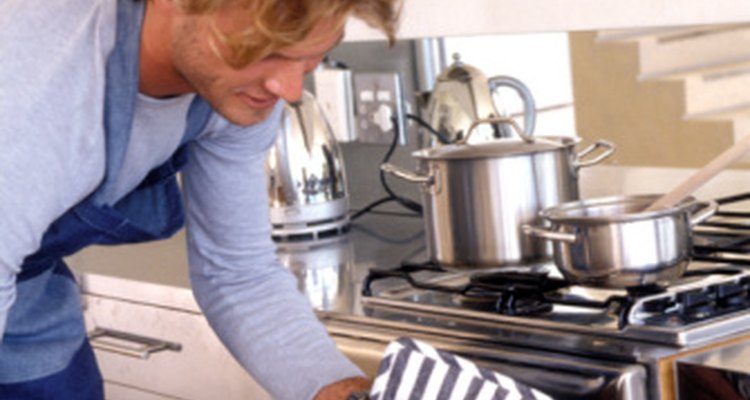
If you do it right, convection oven roasting can result in a beautiful, brown and mouth watering meal. While roasting a stuffed chicken in your convection oven does not necessarily require a change in the ingredients you choose, it does require adjustments to cooking time and/or temperature. Although roasting a stuffed chicken means leaving the skin on during cooking, you can limit the number of additional calories and increased saturated fat levels by using a wire rack during roasting and removing the skin when roasting is complete.
Prepare the chicken for convection roasting just as you do for roasting in your oven. Remove the kidneys, if present, and the giblet bag from the abdominal cavity. Rinse the chicken inside and out with cold water and pat it dry with paper towels.
Spoon cooled stuffing into the neck and body cavities of the chicken. Fill each cavity only about three-fourths full. Overstuffing, especially if you are using a bread based stuffing that expands during roasting, can affect cooking times.
Insert an oven proof meat thermometer into a meaty part of the chicken, such as the inner thigh area, taking care to avoid hitting a bone.
Set the stuffed chicken in a shallow roasting pan with a wire rack and place in your convection oven. Select a roasting pan large enough to leave a 2 inch space between the chicken and the edges of the pan. Air circulation is an important part of convection oven roasting, so leaving air space around and under the chicken is essential. Using a wire rack also ensures that fat drips off, rather absorbs into your chicken.
Set the temperature on your convection oven to 345 to 350 degrees Fahrenheit. Because a convection oven cooks meat more evenly than a traditional oven by using a fan to circulate air, you can roast your chicken using a lower temperature than the traditional 375 degrees Fahrenheit. A general rule is to lower the oven roasting temperature by 25 to 30 degrees Fahrenheit.
Roast the chicken using an estimate of 15 minutes per pound, rather than the traditional 20 minutes per pound. You will not need to baste the chicken as it roasts but you do need to monitor the meat thermometer as you near the end of roasting time. The thermometer should read at least 180 degrees Fahrenheit.
Check the temperature of the stuffing before removing the chicken from the convection oven. Insert an instant read meat thermometer through the body cavity and into the center of the stuffing. The meat thermometer should read at least 165 degrees Fahrenheit.
Remove the roasting pan from the convection oven and allow the juices to settle in the chicken by letting it rest for about 20 minutes. Transfer the stuffing by spooning it into a serving a serving bowl and transfer the chicken to a serving platter using tongs or a spatula.
Related Articles

How to Cook Prime Rib Using an Oven ...
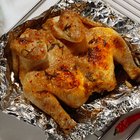
How to Get a Crispy Crust on Roasted ...
How to Cook Pre-Seasoned Porketta

How to Cook a Chicken in a Toaster Oven ...

How to Cook a Standing Rib With the ...
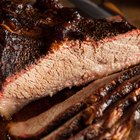
How to Steam a Brisket of Beef

The Best Ways to Make a Baked Moist and ...

How to Make Crock-pot Chicken

The Proper Way to Inject Marinade Into ...

How to Cook Turkey Parts

How to Convection Roast a Boston Butt

How to Grill a Chicken on a Vertical ...

How to Bake Chicken at 375
How to Cook Beef Ribs in an Electric ...

How to Make a Blackbuck Antelope Roast

How to Cook Chicken Thighs
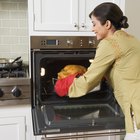
Oven Roasting Tips for Baking a Rival ...

How Do You Tuck the Wings to Roast a ...
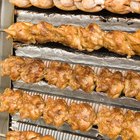
How to Tie a Rotisserie Chicken

Can You Roast Whole Frying Chickens?
References
Tips
- Choose stuffing ingredients with an eye toward health. For example, rather than using a traditional bread and sausage or giblet base stuffing, consider recipes that include ingredients such as brown or wild rice and mushrooms, or experiment with an herb based stuffing that includes a mixture of parsley, savory and sauteed shallots.
Writer Bio
Based in Green Bay, Wisc., Jackie Lohrey has been writing professionally since 2009. In addition to writing web content and training manuals for small business clients and nonprofit organizations, including ERA Realtors and the Bay Area Humane Society, Lohrey also works as a finance data analyst for a global business outsourcing company.
Photo Credits
Pixland/Pixland/Getty Images